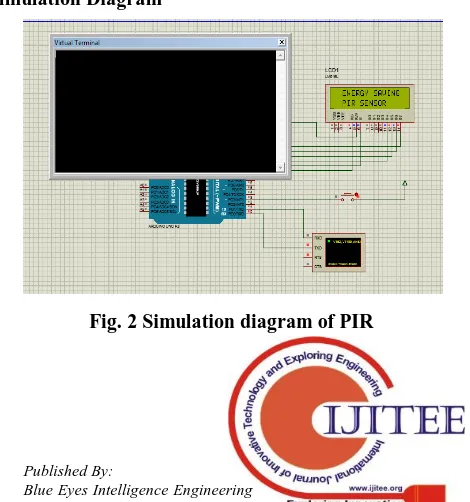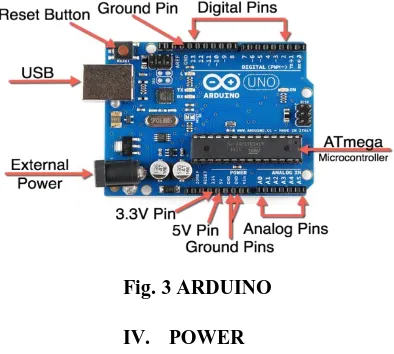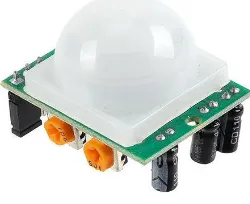International Journal of Innovative Technology and Exploring Engineering (IJITEE) ISSN: 2278-3075, Volume-8 Issue-8S, June 2019
Abstract: As we realize that programmed framework and computerization is the prerequisite of the present innovation. We are pushing toward computerization for quite a while. It is one of the tending subjects. So in this project we will provide automatic electronic appliance on/off using PIR sensor. In this project, a design is proposed using PIR sensor for automation of lights and fans using Arduino with Internet of Things for smart homes. Nowadays we’re having automation of every little electrical device in our homes. Internet of Things is the physical thing embedded with sensors, softwares etc.., without human interaction and computer interaction transaction of data over a network; however, it scales up to include smart cities with connected sensors. Utilizing PIR sensors, the lights will consequently turn on and off as indicated by the power of light.
Keywords: PIR Sensor, Arduino, Wi-Fimodule, IR sensor, Home automation system, IOT
I. INTRODUCTION
These days, the web need ended up a normal interface that a significant number of gadgets use in place will improve the everyday life about numerous individuals. Web aides us to get quick result for huge number of issues capable to interface starting with any of the remote spots which contributes with general expense decrease furthermore vitality utilization. Home mechanization might make portrayed as introduction for innovation organization in the home environment which provides straightforwardness which is more secure with its occupants. Towards utilizing the innovation of web for Things, those examinations Furthermore execution about home mechanization have got extra Normal. A diverse remote advance which has the ability to help a type of remote data exchange, detecting additionally the executives like Bluetooth, WI-Fi and other cell division systems would be utilized to enter bounteous dimensions for wisdom inside the home.
Revised Manuscript Received on May 22, 2019.
P.Eben Sophia, Assistant professor, Department of Electronics and
Communication Engineering, Karpagam College of Engineering, Coimbatore-641032.
Prithvirajan.R, Student, Department of Electronics and Communication
Engineering, Karpagam College of Engineering, Coimbatore-641032
Thirunavukarasu.S, Student, Department of Electronics and
Communication Engineering, Karpagam College of Engineering, Coimbatore-641032
Muthuraj.K, Student, Department of Electronics and Communication
Engineering, Karpagam College of Engineering, Coimbatore-641032
S. Sarmila, Student, Department of Electronics and Communication
Engineering, Karpagam College of Engineering, Coimbatore-641032.
It might provide an interface with home mechanization itself, by means of mobile phone or alternately the internet. People are squandering a lot of power since no recognition to kill the lights, fans and numerous other electrical apparatuses when they are leaving their home.
We have developed a device that can be built-in anywhere in apartments or homes, to avoid those careless mistakes by humans. It will automatically turn off the light by detecting whether humans are present or not. PIR Sensor is utilized to recognize the nearness of human and comprise of IR sensors which are utilized to distinguish certain characters in their environment and it will turn on the electrical machines. Arduino UNO is utilized to control the PIR sensor and electrical apparatuses. Transfer modules are utilized to control the principle voltages and as straightforward as controlling yield like LCD screen.
II. DESIGN
Arduino UNO is utilized to control the PIR sensor and electrical apparatuses. Transfer modules are utilized to control the principle voltages and as straightforward as controlling yield like LCD screen. As Arduino will get a flag from PIR, will turn on the lights, fans or electrical apparatuses. Every single 40 seconds Arduino will check the signs from the PIR sensor and whenever yield is '1' (high)then it won't kill the primary voltage and whenever yield is '0'(low) at that point it will kill the electrical appliances. This design rehashes continuously, by this gadget. The PIR sensor is nearly ranges from 6 meters. And also web server controls all home appliances using Figure 1 internet of things(IOT).
[image:1.595.311.546.571.822.2]Simulation Diagram
Fig. 2 Simulation diagram of PIR
PIR and IR Sensor Based Smart Home
Automation System Using IOT for Energy
Saving Applications
Block Diagram
Fig. 1 Block diagram of PIR and IR sensor based smart home automation system
III. HARDWARE DETAILS 1. Arduino Uno
ARDUINO UNO is the microcontroller which is available as open based on the microchipATmega328P. It has 19 advanced information, a 16 MHz quartz gem, 6 simple data sources, an ICSP header, a USB association, a power jack, and a reset button. This open source Arduino UNO is effectively interfaced to different development sheets; essentially associate to a personal computer with power back up or USB with an air conditioner to-DC connector or battery with more prominent than 5V. You can tinker with your UNO without warring a lot about any kind of implementation and accomplishing something. The Uno board is the first in a progression of USB ARDUINO Figure 3 boards.
Fig. 3 ARDUINO
IV. POWER
The Arduino Uno can be charged by means of the USB association or with an outer batteries more noteworthy than 5Vsupply or 5V DC. The power source is chosen naturally. Outside (non-USB) power can come either from an air conditioner to-DC connector (divider mole) or battery with
2.1mm focus positive fitting. Leads from a battery can be embedded in the Gnd and Vin stick headers of the POWER connector.
The board can work on 6 to 20 volts an outside supply (more noteworthy than 5V). Whenever provided with under 7V, be that as it may, the 5V stick may supply fewer than five volts and the board might be unstable. As, the input voltage more noteworthy than 7V, damage the board by overheating the voltage controller. The prescribed range is 7 to 12 volts.
The power pins are as follows:
VIN. You can supply voltage through this pin. The input voltage to the board when it's utilizing an outside power source (rather than 5 volts from the USB connection, AC to DC connector or other directed power source supply).If providing voltage by means of the power jack, get to it through this stick.
5V.This stick yields a directed 5V from the controller on the board. Providing voltage by means of the 5V or 3.3V pins sidesteps the controller, and can harm your board. The board can be provided with power either from the DC control jack (7 - 12V), the USB connector (5V), or the VIN stick of the board (7-12V).
3V3. A 3.3 volt supply, which is produced by the on-board controller. Most extreme current draw is 50 mA. GND. Ground pins.
[image:2.595.318.534.403.590.2]V. ARDUINO UNO TO ATMEGA328 PIN MAPPING
Fig. 4 Arduino Uno to ATMEGA328 pin mapping Input and Output
Every one of the 14 advanced pins can be utilized as an information or yield, utilizing pinMode(), digitalWrite(), and digitalRead() works on the UNO. They work at 5 volts. These pins can supply or take conveyance of a limit of 40 Mama.
[image:2.595.70.267.520.697.2]International Journal of Innovative Technology and Exploring Engineering (IJITEE) ISSN: 2278-3075, Volume-8 Issue-8S, June 2019
Serial: 1 (TX)and 0 (RX). Used to get (RX) TTL Sequential information and transmit (TX) TTL sequential information. These pins are associated with ATmega8U2 USB-to-TTL Sequential chip with their comparing pins. External Interrupts: 2 and 3. In the event that esteem is low esteem, a rising or falling edge, or an adjustment in esteem, these pins can be designed to trigger a hinder ready. The attachInterrupt() work is utilized to get to these intrudes. PWM: 3, 5, 6, 9, 10, and 11.Utilizing the analogWrite() work it gives a 8-bit PWM yield
SPI: 10 (SS), 11 (MOSI), 12 (MISO), 13 (SCK). Utilizing the SPI library, these pins support SPI correspondence. LED: 13.There is a fixed Driven associated with advanced stick 13. At the point when the yield of the stick is LOW, Driven is off, when the stick is HIGH esteem, the Drove is on.
The Uno has 6 simple data sources, every one of which give 10 bits of goals (for example 1024 distinct qualities), named A0 through A5.
As a matter of course they measure from ground to 5 volts, The AREF stick is utilized to change the upper end of their range and the analog Reference() work. Moreover, a few pins have particular usefulness:
TWI: A4 or SDA pin and A5 or SCL pin. Using the Wire library, Support TWI communication
There are a couple of other pins on the board:
AREF. Utilizing with simple Reference (),reference voltage for the simple sources of info can be fixed.
Reset. Normally used to add a reset catch to shields which hinder the one on the board. As this line LOW '0', microcontroller will reset.
The mapping between Arduino pins and ATmega328 ports. The mapping for the Atmega8, 168, and 328 is indistinguishable.
Communication
ARDUINO can be utilized to speak with a PC, another ARDUINO board or different microcontrollers. The ATmega328P microcontroller Figure 4, utilizing advanced stick 0 (Rx) and computerized stick 1 (Tx) gives UART TTL (5V) sequential correspondence. In ATmega16U2 firmware, no outside driver is needed. It will utilize the standard USB COM drivers. The .inf document on windows operating system is required to incorporate a type of sequential screen which can grant straight forward narrative information to be transferred to and fro from the Arduino board. The RX and TX LED will glow when the information is transmitted using the USB to the sequential chip and between USB and the personal computer connected to the Arduino board. A Product Sequential library permits any of the Uno's advanced pins for sequential correspondence. The ATmega328P additionally underpins I2C (TWI) and SPI correspondence. The ARDUINO programming incorporates a Wire library to disentangle utilization of the I2C transport. • Easy to use for beginner level DIYers and makers. • Multiple DIY Projects.
• Prototyping of electronic product and systems.
• Projects requiring Multiple I/O interfaces and communications.
Pir Sensor
[image:3.595.365.490.199.301.2]PIR sensor recognize an encompassing attributes (person) moving around roughly just inside 10m from the PIR Sensor.PIR Sensors genuine identification run is 5m to 12m.PIR Sensor are essentially made of a pyro electric sensor, which is utilized to distinguish dimensions of infrared radiation. For various basic ventures or things its important to find when an individual has left or entered their home. PIR sensors Figure 5 are unbelievable, they are level control and insignificant exertion, have a wide focal point go, and are easy to interface with.
Fig. 5 PIR Sensor
PIR sensors generally have a 3-stick association at the base or side. One stick will be ground, another stick will be flag and the last stick will be control. Power is as a rule up to 5V. Now and then they don't have direct yield in greater modules .So, rather than that a hand-off is utilized to operate, which case there is ground, control and the two switch relations. Interfacing PIR with microcontroller is easy and plain. The PIR goes about as a DETECTOR. APPLICATIONS
Since, output is Digital its better in listening the stick as high/low. If there is a Signal, it’s perceived as movement of individuals in environment. Until there is movement, the sensor heats up the yield will stay low. The time at which the yield will swing high for several seconds, at that point return low. The yield will cycle in this example until the sensors observable pathway of still once more, if the development proceeds. The PIR sensor needs a warm-up time with an exact true objective to limit fittingly. This is a result of the settling time incorporated into considering nature's space. This is conceivable at wherever from 10 to 60 seconds.
Movement Detection utilizing PIR Sensor: To distinguish nearness of human beings, Passive Infrared Sensor is utilized in its proximity. To control the turning of fans, turn off light and turn off engine Output can be utilized.
To recognize either the nearness of infrared light transmitted from a warm item or nonappearance of infrared light when an article passes a bar produced by another piece of the gadget Figure 5 fundamentally utilized light sensor in movement identification.
radiation) into electric flag called PYRO ELECTRIC SENSORS. It produces an electrical charge, when infrared light strikes a gem.
Like this, PIR sensor recognizes the nearness of warm item (people) inside a region of in the locale of 14 meters. Uses of PIR Sensors
• opening and shutting of lift.
• Automating open and close of entryways. • Reduce mishaps.
• In staircases
• For Basement Parking Area • Shopping Malls and buildings. • For infrared cameras.
Highlights
1. Compact in size.
2. Dual Element Sensor with Low Noise and High Sensitivity.
3. Delay Time adaptable 4. 5V power supply. 5. Inexpensive
6. Standard TTL Output IR Sensor
[image:4.595.318.535.398.568.2]An electronic gadget, that discharges so as to recognize a few objects of the surroundings, IR Sensor is utilized. It can gauge the warmth of a warm article just as distinguishes the movement of the objects(human body). These kinds of sensors estimates just infrared radiation, as opposed to discharging it that is called as a passive IR sensor . The items transmit some type of warm radiations .in infrared radiation. These kinds of radiations are imperceptible to our eyes, that can be distinguished just by an infrared sensor. The producer is basically an IR LED and the locator is just an IR photodiode which is delicate to IR light of a similar wavelength as that radiated by the IR LED., The protections and these yield voltages, change in extent to the greatness of the IR light got, when IR light falls on the photodiode Figure 6.
Fig. 6 IR Sensor Wifi Module
The ESP8266 WiFi Module is an independent SOC with incorporated TCP/IP convention stack can access to your WiFi network, with any microcontroller. The ESP8266
application processor. This module has a ground-breaking enough ready handling and capacity ability that enables it to be coordinated with the sensors and other application explicit gadgets through its GPIOs with insignificant improvement in advance and negligible stacking amid runtime. Its high level of on-chip reconciliation takes into account insignificant outside hardware, including the0front-end module, is intthe0front-ended to involve negligible PCB zone. The ESP8266 underpins APSD for VoIP applications and Bluetooth conjunction interfaces, it contains a self-adjusted RF enabling it to work under every single working condition, and requires no outside RF parts .The uses of ESP8266 are Smart power plugs ,Home mechanization ,Wi-Fi area mindful gadgets, Industrial remote control, Security ID labels. Fig.7 Wi-Fi module
Highlights of ESP8266 o 802.11 b/g/n convention o Wi-Fi Direct (P2P), delicate AP o Integrated TCP/IP convention stack
o Integrated TR switch, balun, LNA, control intensifier and coordinating system
o Integrated PLL, controllers, and power the board units o +19.5dBm yield control in 802.11b mode
o Integrated temperature sensor
o Supports receiving wire assorted variety o Power down spillage current of < 10uA
o Integrated low power 32-bit CPU could be utilized as application processor Implementation of PIR sensor
Fig. 7 PIR & IR Sensor based home automation System Saving Energy
VI. CONCLUSION
[image:4.595.66.274.519.681.2]International Journal of Innovative Technology and Exploring Engineering (IJITEE) ISSN: 2278-3075, Volume-8 Issue-8S, June 2019
REFERNCES
1. A. Adewale and e. al., "design and development of a microcontroller based automation switch for home appliances," International journal of engineering scienceintervention, pp. 24-31, 2013.
2. S. Prasanna and e. al., "Automated IntelligentPower Saving System and Security System,"Research India Publications, pp. 1167-1176,2013. 3. K. Sravani and e. al., "Human Motion DetectionUsing Passive Infrared
Sensor," Internationaljournal of research in computer appliances andtechnology, pp. 28-32, 2014.
4. M. Samiran and K. N. Pabitra, "IR Remotesignal control decoder for home automation,"Engineering Sciences and InnovativeTechnology, pp. 262-267, 2014.
5. M. A. K. Sharma, "Comparative of energyconsumption for wireless sensor networks basedon random grid deployment strategies,"International journal of computer applications,pp. 28-35, 2010.
6. "www.arduino store community andelectronics.htm," [Online]. Available:http://www.arduino store_community and
electronics.htm. [Accessed 21 June 2016].2017 IEEE PES-IAS PowerAfrica351
7. RohaidaHusin, University Technology MARA, Shah Alam, Selangor, Malaysia; “Automatic Street Lighting System For Energy Efficiency Based on Lowcost microcontroller”, ISSN:1437-804x online, January2005,DOI:10.5013/IJSSST,pp.43,4
8. Mustafa Saad, Dept. of Control Engg, college of Electronics & Technology, Baniwalid-Libya, “Automatic Street Light Control System UsingMicrocontroller”,PP. 92-95[9] L. McGarry, “The standby power challenge,” IEEETransactions on Asian Green Electronics, pp. 56-62,2004.
9. Bo-Teng Huang, Ko-Yen Lee, and Yen-Shin Lai,“Design of a Two-Stage AC/DC Converter withStandby Power Losses Less than 1 W,” in Proc. PCC,pp. 1630-1635, Apr. 2007.
10. Jee-Hoon Jung, Jong-Moon Choi, and Joong-Gi Kwon,“Novel techniques of the reduction of standby powerconsumption for multiple output converters,” in Proc.APEC, pp. 1575-1581, Feb. 2008. 11. Hui, S.Y.R., Chung, H.S.H., and Qiu, D.Y., “Effectivestandby power
reduction using non-dissipativesingle-sensor method,” in Proc. PESC, pp. 15-19, Jun.2008.
12. Yu-Kang Lo, Shang-Chin Yen, and Chung-Yi Lin, “AHigh-Efficiency AC-to-DC Adaptor with a LowStandby Power Consumption,” IEEE Transactions onIndustrial Electronics, pp. 963-965, Feb. 2008. 13. Chia-Hung Lien, Chi-Hsiung Lin, Ying-Wen Bai,Ming-Fong Liu, and
Ming-Bo Lin, “Remotely Controllable Outlet System for Home Power Management,” Proceedings of 2006 IEEE Tenth International Symposium on Consumer Electronics(ISCE 2006), St. Petersburg, Russia, pp. 7-12, June28-July 1, 2006.
14. Chia-Hung Lien, Ying-Wen Bai, and Ming-Bo Lin,“Remote-Controllable Power Outlet System for Home Power Management,” IEEE Transactions on Consumer Electronics, pp. 1634-1641, Nov. 2007.



